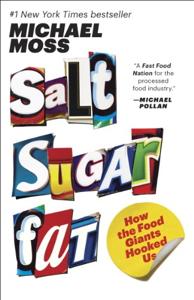
Want to learn the ideas in Salt Sugar Fat better than ever? Read the world’s #1 book summary of Salt Sugar Fat by Michael Moss here.
Read a brief 1-Page Summary or watch video summaries curated by our expert team. Note: this book guide is not affiliated with or endorsed by the publisher or author, and we always encourage you to purchase and read the full book.
Video Summaries of Salt Sugar Fat
We’ve scoured the Internet for the very best videos on Salt Sugar Fat, from high-quality videos summaries to interviews or commentary by Michael Moss.
1-Page Summary of Salt Sugar Fat
Overall Summary
Salt Sugar Fat is a book that describes the modern food industry. It talks about how companies are marketing unhealthy foods to children and adults alike, and people are becoming obese as a result of consuming these products. The author interviews many different people involved in this process, including scientists who have been researching the effects of salt, sugar, and fat on the human body for years.
Industrial food companies use harmful ingredients to make processed foods. They then advertise these products to consumers, including children, much like tobacco companies do. These practices could lead to legal and political consequences for the food industry.
Obesity rates have increased over recent decades, and as a result we’ve seen an epidemic of major diseases. The media blames the food companies because they make people eat too much. Government also accuses the food industry for making unhealthy foods that cause obesity.
Food companies have a problem with the way they’re making their food. They continue to use salt, sugar and fat in their products even though those things are contributing to obesity.
The author visits the research, production, and marketing divisions of sugary food producers. The Pillsbury executive is concerned about his industry’s products’ effects on health.
Moss investigated food poisoning cases, and found that manufacturers manipulate safety procedures. As a result, food is less safe than before.
The author goes to a soda research lab where scientists are working on the perfect recipe for soda. They use their findings to make people want more of their product, and they do this by finding the bliss point—the right amount of sugar that makes it taste good.
Scientists study the body’s reaction to sugar, and they apply that knowledge to make food more appealing. Dr Pepper hires Howard Moskowitz for his expertise in psychology and statistics, which he uses to come up with new products that are popular. Moss eats at a diner, where he finds Dr Pepper disgusting. He is one of many food scientists who create foods other people like but that they themselves do not like. Food scientists and marketers at General Foods invented convenience foods after World War II because women were now working outside the home as well as taking care of their homes, so it was important for them to have convenient meals available in addition to tasty ones. Sugar adds flavor, texture and shelf life to foods; therefore it is used frequently by food manufacturers because of its low cost compared with other ingredients such as meat or vegetables.
Although the government wanted to promote traditional cooking, convenience food won out. John and Will Kellogg started a health retreat that limited unhealthy foods. They produced an unsweetened cereal, but Will added sugar and it became popular. A guest of their retreat invented Grape-Nuts; he later sold his company to Post Cereals Company, which was purchased by General Foods Corporation in 1929. The new owners then used advertising strategies to make their products more appealing to consumers than other companies’. For example, they advertised their cereals as healthy alternatives for people who were concerned about dental health because sugar is bad for teeth (and therefore can lead to cavities). Then dentists began pushing for regulation of ingredients like sugar in order to protect consumers’ dental health. Jeffrey Dunn had a senior position at Coca-Cola after marketing the soda throughout North America and South America; however, when he realized how harmful sugar was he left Coca-Cola and developed healthier products instead.





